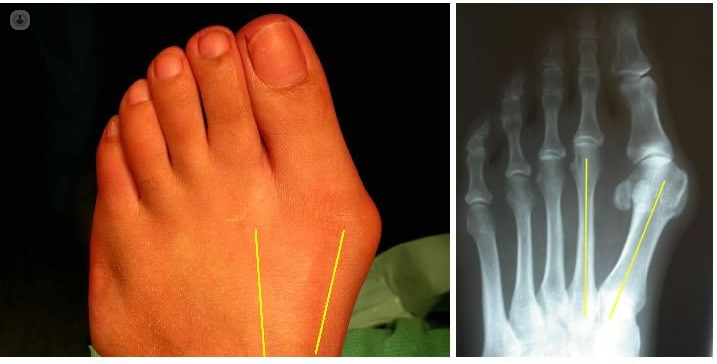


What is a bunion?
The hallux valgus or bunion is a bony deformity at the base of the big toe on the inside of the foot. It occurs when the big toe is pushed inward towards the rest of the toes, forcing the joint at the base of the foot outwards, causing the appearance of a bony lump or protrusion on the inside of the foot.
What are the symptoms of a bunion?
The main symptoms are a bulging bump in the area around the joint between the big toe and the rest of the foot, and the associated pain and inflammation, which usually get worse when walking. As the bunion grows, it will become more inflamed and uncomfortable. Other symptoms include:
- Swelling and redness around the joint on the inside of the foot.
- Calluses and corns, which develop where the big toe overlaps with the second toe.
- Reduced movement at the joint.
- Joint pain that is aggravated by the pressure of wearing shoes.
- The big toe points in the direction of the other toes.
What causes bunions?
Possible causes of bunions are:
- Genetic factors – it is thought that a certain foot type is more susceptible to bunion development.
- Arthritis is often associated with bunions
- Foot injuries
- Inappropriate footwear – the use of narrow-toed and high-heeled shoes can also force the big toe inwards and lead to the development of a bunion.
Can bunions be prevented?
To prevent bunions it is vital to pay attention to the development of our feet. When there are calluses or corns on the inside of the big toe or if you notice it is starting to point inwards, it is advisable to take some kind of measure to prevent it from getting worse. It may be impossible to prevent bunions, but the best way to lower your chances is to choose the right footwear:
- Make sure your shoes are the correct size, with room to move your toes freely
- Avoid shoes with high heels and/or pointy toes.
- Your shoes should conform to the shape of your feet.
What is the treatment?
Bunions are often manageable conditions, and non-surgical treatments to deal with the symptoms should always be tried before surgery. These include:
- Painkillers or anti-inflammatory drugs
- Local application of cold, e.g. ice packs
- Bunion pads – these may be made of gel or fleece and cushion the bunion, preventing it from rubbing in the shoe. They can often be purchased over the counter. Your doctor can advise you on their use.
- Insoles, splints, and toe spacers may also help to make your foot more comfortable in your day-to-day life. Again, consult your GP or a podiatrist for advice on if and how you should use these.
- Correct footwear – make sure you are wearing roomy, comfortable shoes, with plenty of space to move your toes.
Surgey, called bunionectomy, is only indicated in severe cases where walking becomes highly difficult. Through this procedure, the surgeon can realign your toe and remove the bony protuberance and swollen tissue. However, full recovery can take weeks, or even months, and even then bunions can recur. For this reason, it is important to only wear appropriate shoes and take care of your feet after surgery.
